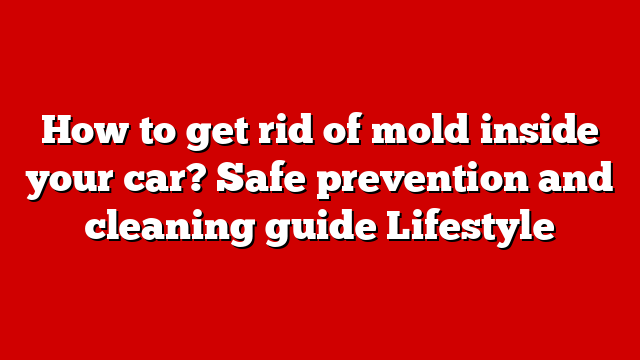The appearance of mold is not limited to wet and closed buildings, but can also grow inside cars, especially in places that are constantly exposed to moisture.
The danger of mold lies in its ability to destroy fabrics and leather and its direct impact on the health of passengers, which requires dealing with it seriously and quickly.
Places of mold appearing inside the car
According to a report by the German auto magazine “Otto Zeitung”, the mold tends to appear in the parts made of natural fibers or fabrics, such as fabric seats, carpets on the car floor, the luggage box, and the cabin roof cladding.
It may also appear on the wheel and transmission handle, while the solid plastic surfaces remain less likely to develop mold.
Mold growth is always associated with a source of moisture, whether due to water leakage from windows, roof opening, or as a result of the introduction of clothes and shoes wet into the cabin.
Hence, the first step in control is to determine the source of moisture and eliminate it before proceeding to clean the affected areas.
Ways to remove mold from the components of the car
- Fabric seats and surfaces: It is preferable to use delicate detergents dedicated to fabrics, provided that they are chlorine -free or hydrogen peroxide, in order to avoid fabric damage or change its color, and it is also recommended to test the detergent in an invisible area first to ensure its safety on the material.
- Plastic surfaces: Mold can be removed from the plastic parts using pure alcohol or concentrated vinegar, and the material must be applied to a soft cloth and wipe the surface gently and then dry it well after finishing.
- Glass and window frames: Mold on the glass usually appears in the form of accurate deposits, especially around rubber tires, where dust and moisture accumulate, and in some cases it may be necessary to decode the glass to clean the hidden areas, and products that contain chlorine are effective in this case.
- air conditioner: The air conditioning system is one of the most vulnerable environments to the reproduction of mold as a result of the accumulation of moisture inside it, and this appears in the form of an odd smell when running, and in this case it is recommended to go to a specialized service center for cleaning the system completely, including changing the internal air filter, and it is advised to operate the air conditioner from time to time even in the winter to reduce the accumulation of moisture.
Preventive advice to reduce mold growth
Moisture is the decisive factor in the reproduction of mold, so the car corner is recommended in dry places, while making sure that the windows and doors are closed tightly, but in old cars, places that may be leakage should be examined, and not to leave clothes or wet fabrics inside the car, and in the winter it is preferable to clean shoes from clay before entering the car.
Home means to combat mold
In addition to commercial materials, some effective household means such as sodium bicarbonate, white vinegar, iodine salt and eodoplalli alcohol can be used.
During the cleaning, it is recommended to wear a muzzle and gloves to protect the respiratory and skin, as well as protect the eyes, while washing the clothes that were worn immediately after completion.
Alcohol is prohibited directly on the surfaces due to the risk of ignition, and the tools used must be eliminated or washed well, especially if they are contaminated with mold.
When should specialists go?
If the mold is widely spread inside the car, the home intervention may not be sufficient, and in this case it is advised to go to specialized cleaning workshops, where the seats are dismantled and a deep cleaning using special materials or techniques such as enzymes and dry snow.
The treatment is also completed by replacing the air filter and internal air treatment with ozone that kills the germs and unwanted odors.

